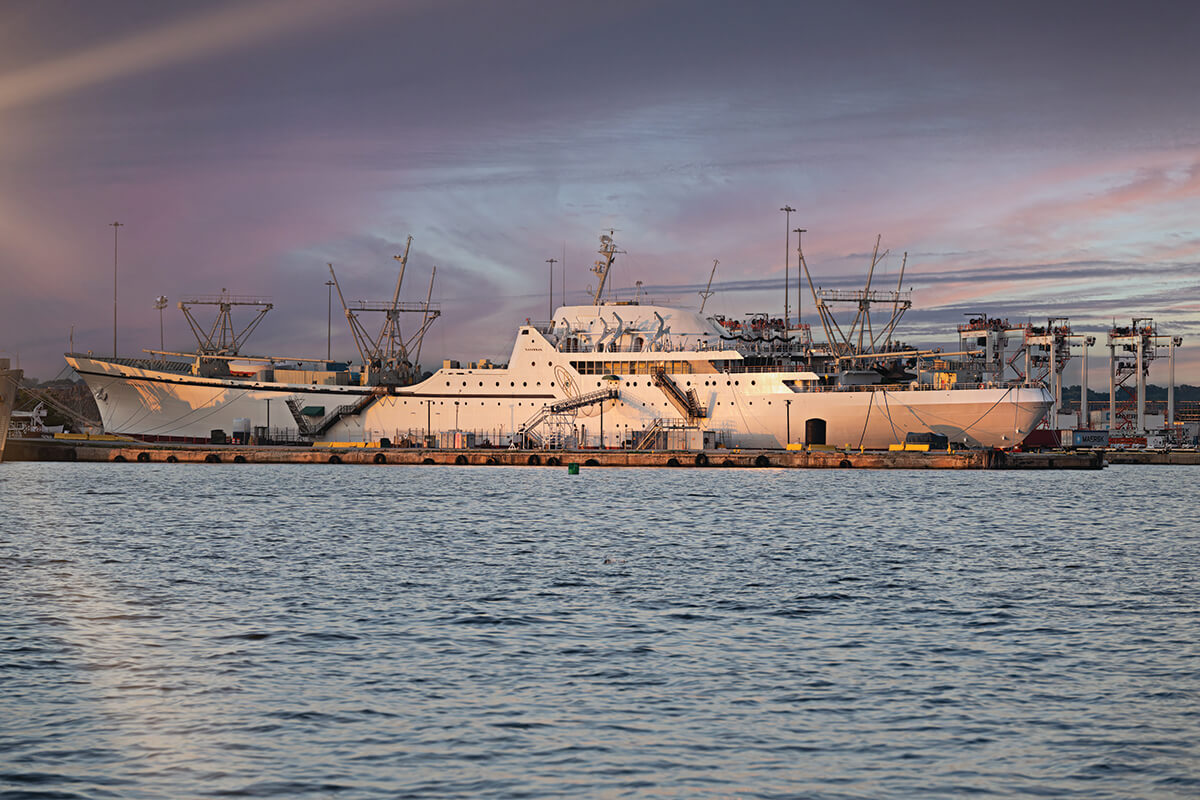History & Politics
Back to the Future: NS Savannah, The World’s First Nuclear-Powered Liner, Is Open for Tours
Moored at a desolate former Canton grain pier, the circa-1959 vessel appears ordinary from the outside, but inside it's a mashup of 'Star Trek' on sea and 'Mad Men' on vacation.

Moored at a desolate former Canton grain pier, the NS Savannah looks like an ordinary cruise ship upon approach. Well, except for the giant atomic “whirl”—the familiar representation of electrons orbiting a nucleus—splashed across its port side entrance.
Inside, the world’s first nuclear-powered commercial liner, christened in 1959, appears to be a mash-up of Star Trek on sea and Mad Men on vacation. There is a sunny deck and swimming pool, 75-seat midcentury modern dining room (including mini-atomic symbols on the dinnerware sets), and a retro cocktail lounge that doubled as a movie theater but also could’ve doubled as a James Bond set. Close your eyes and you can almost hear Sean Connery ordering a martini “shaken, not stirred.”
![FullSizeRender[3]](https://www.baltimoremagazine.com/wp-content/uploads/2024/09/FullSizeRender3-scaled.jpg)
![FullSizeRender[5]](https://www.baltimoremagazine.com/wp-content/uploads/2024/09/FullSizeRender5-scaled.jpg)
![FullSizeRender[11]](https://www.baltimoremagazine.com/wp-content/uploads/2024/09/FullSizeRender11.jpg)
![FullSizeRender[14]](https://www.baltimoremagazine.com/wp-content/uploads/2024/09/FullSizeRender14.jpg)
![FullSizeRender[1]](https://www.baltimoremagazine.com/wp-content/uploads/2024/09/FullSizeRender1-scaled.jpg)
Launched by President Eisenhower with great fanfare to promote his Cold War-era Atoms for Peace Program, the ship possessed no weapons, but was powered by a very real nuclear reactor, which sat in the bow’s hull, just a stroll from the ship’s staterooms.
It propelled the Savannah through the Panama Canal, to Seattle’s World’s Fair and to European ports for over a decade without ever needing to refuel. Its nuclear-powered engine required a highly trained crew, but provided a near limitless source of energy. The amount of uranium fuel that the ship spent over its passenger-and cargo carrying lifetime could fit in a small gift box.
Today, however, following the removal and disposal of its reactor in 2022, the ship is heading for decommission while the Navy looks for a buyer to purchase the nearly 600-foot vessel as a historic preservation project and maritime museum.
To that end, volunteer docents began leading public tours of the remarkably preserved, back-to-the-future ship last year, which includes visits to the analog engine and technicolor control rooms.
![FullSizeRender[6]](https://www.baltimoremagazine.com/wp-content/uploads/2024/09/FullSizeRender6.jpg)
![FullSizeRender[4]](https://www.baltimoremagazine.com/wp-content/uploads/2024/09/FullSizeRender4-scaled.jpg)
As part of its mission, the Savannah was built for curious visitors on its globe-trotting voyages. “Does anyone want to push the scram?” guide Matthew Roof asks a lively group on a recent afternoon, barely getting his sentence out before a couple of hands go up. “It’s the, ‘Oh shoot!’ emergency shut off button,” he explains.
According to one story, Enrico Fermi, a Manhattan Project member, created the clever “scram” (Safety Control Rod Axe Man) acronym. The stop-sign red button is disconnected, of course, but that doesn’t seem to dim anyone’s enthusiasm.
Later, after visiting the ship’s barbershop, beauty salon, and health physics laboratory, intended to monitor the effects of the nuclear reactor on the crew, Roof points out the c. 1960 Raytheon Radarange microwave in the Savannah’s kitchen.
![FullSizeRender[8]](https://www.baltimoremagazine.com/wp-content/uploads/2024/09/FullSizeRender8.jpg)
“Standing next to this,” he says, of the refrigerator-sized microwave, “you would’ve received 3-4 times more radiation than anything released from the nuclear reactor.”